#self-help spoof
Explore tagged Tumblr posts
Text
me bothered out of my mind now thinking abt how in the movie i watched w my friend yesterday they had a cop set someone’s bail when judges set bail and not the police and how the movie did not remotely try to be accurate to the judicial system and then i have to close my eyes and remind myself that the movie also had a snowman turn into a real guy but honestly and truly i can suspend my disbelief for that but NOT the bail thing i am serious
#michelle speaks#ok i was being picky abt the snowman thing too tho bc i kept pausing it & being like well how does he know what stealing is.#how come he doesnt know social customs but he knows english and what many different things are. and i had to stop bc i was like i’m going#to be doing this the whole time but it never stopped bothering me……like how are we deciding what things he knows? based on what exactly?#i am sooooo nitpicky i know i can’t help it 😔 anyway i was so excited to watch that movie bc the description and the title seemed so camp#but no they were trying to make a good movie and they failed 😔 like u could have just been camp abt it…..no 😔#these dumbass christmas rom coms need to stop taking themselves so seriously. spoof the genre i’m BEGGING!!!!#i mean i KNOW i could find a spoof out there but i think these movies in general need to lean into it more. be more self aware.#u r making a movie w a stupid concept u need to accept that. for ONCE!!!!!!
1 note
·
View note
Text

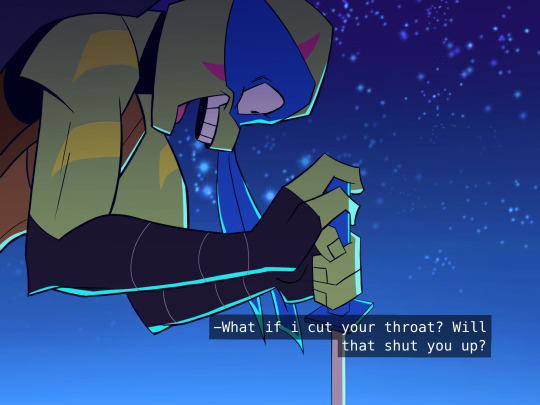
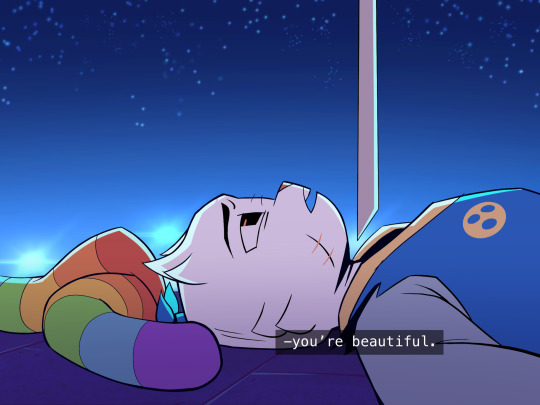
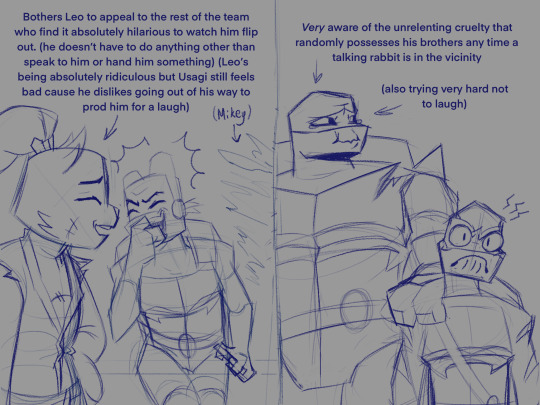
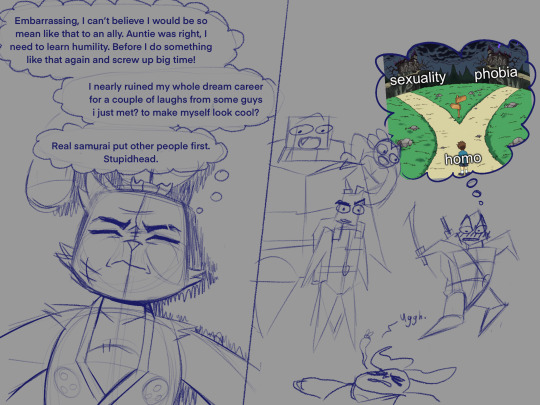

Introducing; Yuichi Usagi-Cuddles!
There’s a slight typo in his basic character bio, (first, grey image) other than “yuich,” his family in America lives in the part of the hidden city under Jersey. He lives in Jersey. He’s a Jersian. So in terms of leosagi, it’s gonna be an enemies-to-lovers comedy-of-errors muahahahaha!!
More (a LOT more) info about him as his own guy under the cutoff :D ⬇️
Basically; He’s a silly guy! I feel like his kinda buffoonish, embarrassing personality in canon is simultaneously PERFECT for Rise’s writing style & grievously underrated in fanon depictions. So he’s this clownish type of character, haha.
Okay, time to go hyperfixation mode.
Adhd & his stubborn attitude;
He has ADHD! Executive function issues makes it hard for him to start tasks & manage himself, so he relies on his teams (the Mad Dogs when he’s training & the Rise equivalent to his canon friend group on his own time) to not only instruct him, but also hold him accountable & keep him on task. He’s body-doubling without even realizing it.
Although, he resents the things he does to accommodate his disability. He doesn’t notice that doing the things he does genuinely helps or why so he thinks he’s using them as a crutch because of incompetence. Every time he gets stubborn and ignores the things he needs to do, he crashes and burns. When he was new in town with no teacher & no friends who liked martial arts, he became a huge sad sack until the kraang invasion.
His character arc is about being able to rely on other people & accommodations. That relying on a bit more help than other people doesn’t make you incompetent, choosing to seek out the support you need so you can do your best is the true mature thing to do. I was inspired by canon Yuichi’s struggles with paying attention and Rise’s themes of cooperation. (& also my own experience with adhd and learning with executive function issues & junk)
Relationships w/ the turtles;
The Mad Dogs agree to let him like, intern with them? So he can see what it’s like to be a vigilante, they offer him advice and they occasionally go on low to mid-tier missions with his help. They take him on cause they think more heroes and allies out there, the less work they have to do haha. Also, one of the writers mentioned a season 3 would have them adjusting to being ~official heroes,~ I think this would be them trying to be “real.”
He’s closest friends with Mikey out of the whole group! (Adhd solidarity) Then it goes Donnie -> Raph -> and finally Leo (for now muahaha)
I tried to give Leosagi an interesting dynamic with constructing his character like this; They have similar insecurities from drawing self-worth from technical capabilities that they can develop past together, but Leo is clever and calculating about it vs Yuichi being rash and impulsive. So like smart x stupid but they’re the same actually.
His Family in Jersey;
He speaks english fluently because he’s visited his American family frequently his whole life, they’re very close. He has an accent though since he mainly speaks Japanese.
I haven’t fleshed out this concept enough, but I think members of his jersey/Cuddles half of the family would be spoofs of characters from the original yojimbo comics, implied to be reincarnations? Except Miyamoto ofc. (i’ll explain later..)
Reusing the ninja orphans plotline from the original show, his family utilizes their cute appearances to run an orphanage too. They wonder why this Chizu lady is constantly showing up with unhoused children, but they’re just grateful they’re safe now.
Everyone in his family HATES Mrs. Cuddles, they all think she’s in prison and are happy about it. She might’ve given him that scratch on his face.
Additional;
He is gay.
Thank you for your time.
#rise of the teenage mutant ninja turtles#rise of the tmnt#artists on tumblr#rottmnt#leosagi#leoichi#tmnt#tmnt fanart#adhd#adhd character#rottmnt usagi#tmnt leonardo#rottmnt leo#gonetoforks’ art
279 notes
·
View notes
Note
Fic authors self rec! When you get this, reply with your favorite five fics that you've written, then pass on to at least five other writers. Spread the self-love ❤️
This week has been hell and now that I'm finally coming to the end of it, I'm going to sit down & enjoy this! Sorry in advance for the length.
My favorite fics vacillate wildly depending on my mood, interest, and the time of year, but right now, I think this is what I've got. In no particular order:
Invicta, Invictus (2016)
Magister AU. Hawke ends up owning Fenris while in Minrathous & they fall in love anyway. This fic was difficult to write for a lot of reasons (a main one just being my fear of not doing justice to the premise and underselling the slavery aspect), and it took nearly a year to finish between the writing itself, the rewriting and additional scenes required from @jadesabre301's beta, and final edits. By the time I started posting I felt confident that I'd written something solid, but despite the otherwise positive response, I did end up receiving a series of extremely angry, lengthy critical comments from someone who basically accused me of perpetuating the glorification of rape, the enslavement of people of color, and the entrenchment of cruelty against victims of sexual assault. (I vividly remember a comparison between Thomas Jefferson & Sally Hemings.)
This came out of the blue from someone I knew & had otherwise quite respected; it was a blow that shook my confidence to the core, despite several wonderful people reaching out to me at the time, and while I finished posting the fic, I completely stopped writing otherwise. I ended up not writing anything of significance for three full years afterwards. It wasn't until I got extremely drunk on a work trip (after a personal dinner, no colleagues around) and went back to my hotel to jot down the first lines of the Hawke-is-rescued-from-the-Fade fic that I even entertained the idea of picking the hobby back up.
Now, looking back after almost ten years, I've long come to terms with her criticism. I've decided that I disagree with her, that I'm actually still okay with what I wrote, and that I'm proud of the work I did in that fic. I think the premise is good and the examination of the social and political structures is sound, and I think the fic does what it needs to where the relationship strains against the societal boundaries around it. Not to mention I think it has some of my best Fenris characterization I ever managed, and some of my better Hawke jokes. I think the letter exchange at the end is effectively poignant even after all this time (though I do wish I'd written Danarius's actual death a little differently), and I still find the ending as they approach Kirkwall very satisfying. I'll also never turn down a chance to let Varania have a moment or two.
I'm proud of this one, and I'm glad I wrote it.
A Midwinter's Carol; in Prose; Being a Ghost Story of Baldur's Gate (2023)
I think this fic has some of my best technical mimicry I've ever managed. I've always enjoyed a good stylistic parroting, but this was the first time I'd attempted Dickens, and I genuinely think I did a good job. 😂 I've always been fascinated by the mechanics of language, and I had a great time spoofing his oddly frank addresses to the reader and his serpentine asides.
It's quite short—less than 10k—but I think it does exactly what it's supposed to, and I'm genuinely proud of some of the AU elements. @eponymous-rose gave me Christmases Past and Present, so I can't lay claim to those (aside from execution), but the way Future's demand resolves & the Thayan book standing in for the door knocker were all mine, and I still think they're genius, ahaha. (I also fully acknowledge that I owe Jade big time for helping me clarify the final deal Astarion strikes.)
I think the wordplay throughout of what it means to be redeemed is well written, and I'm genuinely pleased with the turn of the mood during the Future sequence. I can tell my love of flippant characters having stark face-to-face encounters with gods is probably a little strong at the end, but Megan Whalen Turner was a formative influence, and I still love it the way it came out here. This is a fic that did exactly what I wanted it to from start to finish, and I love rereading it.
I also think Astarion refusing to participate in the narrative and Tav's modern voice against the Dickensian backdrop are utterly hilarious.
Iron Bound (2023)
This is the most ambitious project I've ever tackled, even considering Invicta above. I knew this would be a long fic, and while I'd daydreamed about scenes from it for nearly a decade, I genuinely didn't know if I had the technical ability to execute it the way I wanted. Once I finally, finally, finally sat down to write it, the words came out like butter, and I wrote almost 70k words in two weeks.
This fic was interesting because it included a love triangle, which is not something I have ever had the slightest interest in reading or writing, but I felt the relationships were strong enough between all three pillars that I wanted to give it a shot. I love Hawke & Fenris, obviously, but the Fenris + Sebastian brotherhood is likewise vitally important to me, and I've always treasured the Sebastian + Hawke friendship as well. Getting to examine all three of them closely here was wonderful from start to finish, and I loved looking at where the lines strained and grew lax as they got to know each other.
Likewise, I've also adored characters who have to face the conflict between love and duty, and this premise let me marinate in every part of the idea. Knowing that I'd be able to give them all happy endings—knowing that they'd be rewarded for doing the right thing—was very pat and yet very satisfying, and I enjoyed every minute of the tension before the resolution.
This fic was in many ways an homage to Patricia McKillip, one of my favorite authors, and also a frank wish-fulfillment exercise for me. This is the one where everyone lives. This is the one where no one suffers for too long. Malcolm, Carver, Bethany, Leandra—even Varania and Sebastian and Anders and the dog. Everyone lives. Everyone is happy and loved and fed and secure and will remain so for the rest of their lives, and I remain thoroughly unapologetic for it.
I do think (despite Jade's attempts to correct it) that there's some marked narrative clumsiness in the back third, and with a little distance I can see ways I could have revised the Danarius confrontation and the series of epilogues to hang together more cleanly. There are also some heavy-handed sequences regarding the broader world politics which I think stand out against what is otherwise fairly mature writing, and I wish I'd threaded those through a bit more deftly.
That said, I'm still immensely proud of this project, and once I finish this post I'm probably going to reread it start to finish. 😂
This Lethal Light Falls Softly (2023)
I was very passionate about the central conceit of this fic, and I think it shows. It's cleanly written with no wasted time—even rereading it now for this post, there's only one exchange I'd still tweak—and I'm very happy with the way I wrote the Tav & Astarion relationship at this stage. They're a wholly different beast to Fenris & Hawke, who are friends for seven years before they finally embark on a real relationship; Tav & Astarion know each other maybe a few weeks before they sleep together for the first time, and even with the most generous possible interpretation I don't think the game can take more than a handful of months. This meant I was writing lovers with new-to-me insecurities, and with Astarion's own basketful of bugaboos on top of that, everything felt fresh and exciting and a little terrifying. I think you can feel that energy in the prose, and I really like it.
Aside from that, I'm very happy with the solution I came up with to Astarion's vampirism. It was hardly inventive, but I did feel it was both practical and lore-friendly, and I felt like its cost (Tav's absence for Astarion, the exhaustion and battle and injuries for Tav) balanced out the number of boons it provided. It also made negating the vampiric effects an active, ongoing choice for Astarion, which I deeply prefer over more permanent solutions like True Resurrection or a god restoring him to mortality.
I also just honestly think it's just fun to read. I like Astarion being snippy and short-tempered while still being overjoyed to see Tav alive. I like Tav confronting the idea that Astarion loves her as much as she loves him and that her silent absence was an active harm to him. I think I did a pretty good job setting the scenery and conveying the appropriate atmosphere where it was important, and I think there are some turns of phrase throughout that came out quite lovely.
I also think ending on the button of him seeing himself in the mirror is hilarious. (Not pictured: Tav having to ask him to put down the hand mirror for literal weeks.)
ah! this grief like cold bells ringing (2020)
This is probably the most difficult fic I've written in terms of headspace. COVID's forced isolation was particularly awful for me, and I didn't know how to handle it except to try to write it out of me. This, like Iron Bound, contained something I never thought I'd write (rape/rape aftermath), but the gravity of the situation and the world at the time seemed to demand something likewise grave, and I ended up feeling like it was an appropriate choice. Hawke has been a tool of many kinds for me over the years, and I remain both glad and weirdly grateful for her resilience.
This was also the first fic where I felt like I didn't shy away from or veil Tevinter's atrocities (a necessary artifact of the premise). While it was hard to write, it wasn't hard to write, and looking back I'm glad I made the choices I did; I think to hamstring the severity of the moment would have broken the story's teeth and dampened the recovery which came after. The instinct to quit flinching away was the right one, and I think the fic is better for it.
I also think this is some of the most effective writing of catharsis I've ever managed. When I'm having a really difficult time and need to read a moment of recovery, the second chapter of this fic is always my first stop. I've actually only reread the first chapter a few times since I posted (usually the pain's not the part I need), but I've reread the second chapter a hundred times or more.
I also do think that the style of the prose—a little flatter and more direct than I usually write—came out well, especially given the subject matter. While I'd prefer never to go back to that emotional place, I'm glad this came out of it.
Honorable Mention:
Lacrimosa (2011). Still one of the oneshots I'm proudest of. I think it's technically proficient and emotionally very effective, and I love the structure of it.
A Detailed Accounting of the Rigorous and Remarkable Struggles Faced by One Fereldan Refugee in the Singularly Capricious City of Kirkwall, as Experienced by the Illustrious Author (2022). While the writing is not the best I've ever managed (it began life as a warm-up exercise, after all), it took ten years to finish, and I'm deeply proud of both finishing it and of the execution of several sections.
Find Me a Wayward Sun (2023). I like the emotional complexity of this fic very much. This was the first place where I felt like I really started to understand the dynamic between Tav & Astarion, especially in the complicated back half of Act Two, and I've gone back to it several times when I need to recapture that feeling of confused selfishness and nascent, uncertain affection.
#quark replies#wufflesvetinari#baldur's gate 3#dragon age#fenris#hawke#fenris/hawke#tav#astarion#tavstarion#long post
55 notes
·
View notes
Text
You can’t shop your way out of a monopoly

I'm on tour with my new, nationally bestselling novel The Bezzle! Catch me in TUCSON (Mar 9-10), then SAN FRANCISCO (Mar 13), Anaheim, and more!

If you're running a business, you can either invest at being good at your business, or good at Google SEO. Choose the former and your customers will love you – but they won't be able to find you, thanks to the people who choose the latter. And if you're going to invest in top-notch SEO, why bother investing in quality at all?
For more than a decade, Google has promised that it would do something about "lead gens" – services that spoof Google into thinking that they are local businesses, pushing down legit firms on both regular search and Google Maps (these downranked businesses invested in quality, not SEO, remember). Search for a roofer, a plumber, an electrician, or a locksmith (especially a locksmith), and most or all of the results will be lead-gens. They'll take your call, pretend to be a local business, and then call up some half-qualified bozo to come out and charge you four times the going rate for substandard work:
https://www.nytimes.com/2016/01/31/business/fake-online-locksmiths-may-be-out-to-pick-your-pocket-too.html
Some of them just take your money and they "go back to the shop for a tool" and never return:
https://www.riverfronttimes.com/news/when-a-fake-business-used-a-real-st-louis-address-things-got-weird-32087998
Google has been promising to fix this since the late aughts, and to be fair, it's a little better. There was once a time when a map of Manhattan showed more locksmiths than taxis:
https://blumenthals.com/blog/2009/02/18/google-maps-proves-more-locksmiths-in-nyc-than-cabs/
But GMaps is trapped in the enshittification squeeze. On the one hand, the company wants to provide a good and reliable map. On the other hand, the company makes money selling "ads" that are actually payola, where a business can pay to get to the top of the listings or get displayed on the map itself. Zoom out of Google's map of central London and the highlighted landmarks are a hilarious mix of "organic" and paid listings: the British Museum, Buckingham Palace, the Barbican, the London Eye…and a random oral and maxillofacial clinic in the financial district:
https://twitter.com/dylanbeattie/status/1764711667663831455
Hell of a job "organizing the world's information and making it universally accessible and useful," Big G. Doubtless the average Londoner finds the presence of this clinic super helpful in orienting themselves relative to the map on their phone screens, and it's a real service to tourists hoping to hit all the major landmarks.
It's not just Maps users who'd noticed the rampant enshittification. Even the original design team is so horrified they're moved to speak out about the moral injury they experience seeing the product they worked so hard on turned into a giant pile of shit:
https://twitter.com/elizlaraki/status/1727351922254852182
Now, when it comes to locksmiths, I'm lucky. My neighborhood in Burbank includes the wonderful Golden State Lock and Safe, which has been in business since 1942:
https://www.goldenstatelock.com/
But you wouldn't know it from searching GMaps for a locksmith near me. That search turns up a long list of scams:
https://www.google.com/maps/search/locksmith/@34.1750451,-118.369948,14z/data=!3m1!4b1?entry=ttu
It also turns up plenty of Keyme machines – these are private-equity backed, self-serve key-cutting machines placed in grocery stores. Despite Keyme calling itself a "locksmith," it's just a badly secured, overcaptilized, enshittification-bound system for collecting and retaining shapefiles for the keys to millions of homes, cross-referenced with billing information that will make it easy for the eventual hackers to mass-produce keys for all those poor suckers' houses.
(Hilariously, Keyme claims to be an "AI" company):
https://www.businesswire.com/news/home/20200114005194/en/KeyMe-Raises-35-Million-to-Further-Its-Mission-of-Building-the-Premier-Locksmith-Services-Company-in-the-Nation
But despite the fact that you can literally see the Golden State storefront from Google Streetview, Google Maps claims to have no knowledge of it. Instead, Streetview labels Golden State "Keyme" – and displays a preview showing a locksmith using a tool to break into a jeep (I'd dearly love to know how the gadget next to the Slurpee machine at the 7-Eleven will drive itself to your jeep and unlock the door for you when you lose your keys):
https://www.google.com/maps/place/KeyMe+Locksmiths/@34.1752624,-118.3487531,3a,75y,350.19h,90.21t/data=!3m6!1e1!3m4!1ssHrtqjqvgFir3NBauMy13Q!2e0!7i16384!8i8192!4m15!1m8!3m7!1s0x80c2959cd65dbb1b:0x4b3744cf87492a71!2sBurbank+Blvd+%26+N+Hollywood+Way,+Burbank,+CA+91505!3b1!8m2!3d34.1750025!4d-118.3493484!16s%2Fg%2F11f37_3lq8!3m5!1s0x80c2951cedbf4d39:0xe8ff9fd5872e66e9!8m2!3d34.1755176!4d-118.349!16s%2Fg%2F11mw7nr4fx?entry=ttu
It's pretty clear to me what's going on here. Keyme has hired some SEO creeps and/or paid off Google, flooding the zone with listings for its machines. Meanwhile, Golden State, being merely good at locksmithing, has lost the SEO wars. Perhaps Golden State could shift some of its emphasis from being good at locksmithing in order to get better at SEO, but this is a race that will always be won by the firm that puts the most into SEO, which will always be the firm that puts the least into quality.
Whenever I write about this stuff, people inevitably ask me which search engine they should use, if not Google?
And there's the rub.
Google used predatory pricing and anticompetitive mergers to acquire a 90% search market-share. The company spends more than $26b/year buying default position in every place where you might possibly encounter a new search engine. This created the "kill zone" – the VC's term of art for businesses that no one will invest in, because Google makes sure that no one will ever find out it exists:
https://www.theverge.com/23802382/search-engine-google-neeva-android
That's why the only serious competitor to Google is Bing, another Big Tech company (Bing is also the primary source of results on Duckduckgo, which is why DDG sometimes makes exceptions for Microsoft's privacy-invading tracking):
https://en.wikipedia.org/wiki/DuckDuckGo#Controversies
Google tells us that the quid-pro-quo of search monopolization is search excellence. The hundreds of billions it makes every year through monopoly control gives it the resources it needs to fight spammers and maintain search result quality. Anyone who's paid attention recently knows that this is bullshit: Google search quality is in free-fall, across all its products:
https://downloads.webis.de/publications/papers/bevendorff_2024a.pdf
But Google doesn't seem to think it has a problem. Rather than devoting all its available resources to fighting botshit, spam and scams, the company set $80 billion dollars alight last year with a stock buyback that was swiftly followed with 12,000 layoffs, followed by multiple subsequent rounds of layoffs:
https://pluralistic.net/2024/02/21/im-feeling-unlucky/#not-up-to-the-task
The scams that slip through Google's cracks are sometimes nefarious, but just as often they're decidedly amateurish, the kind of thing that Google could fix by throwing money at the problem, say, to validate that new ads for confirmed Google merchants come from the merchant's registered email addresses and go to the merchant's registered website:
https://pluralistic.net/2023/02/24/passive-income/#swiss-cheese-security
Search is a capital intensive business, and there are real returns to scale, as the UK Competition and Market Authority's excellent 2020 study describes:
https://assets.publishing.service.gov.uk/media/5fe4957c8fa8f56aeff87c12/Appendix_I_-_search_quality_v.3_WEB_.pdf
But Google doesn't seem to think that its search needs that $80 billion to fight the spamwars. That's the thing about monopolists, they get complacent. As Lily Tomlin's "Ernestine the AT&T operator" used to say, "We don't care, we don't have to, we're the phone company."
That's why I'm so excited about the DOJ Antitrust Division monopolization case against Google. Trusting one company to "organize the world's information and make it universally accessible and useful," was a failure:
https://www.justice.gov/opa/pr/justice-department-sues-google-monopolizing-digital-advertising-technologies
I understand why people want to know which search engine they should use instead of Google, and I get why, "There aren't any good search engines" is such an unsatisfactory answer. I understand why each fresh round of printer-company fuckery prompts people to ask "which printer should I get?" and I understand why "There are only six major printer companies and they're all suffering from end-stage enshittification" isn't what anyone wants to hear.
We want to be able to vote with our wallets, because it's so much faster and more convenient than voting with our ballots. But the vote-with-your-wallet election is rigged for the people with the thickest wallets. Try as hard as you'd like, you just can't shop your way out of a monopoly – that's like trying to recycle your way out of the climate emergency. Systemic problems need systemic solutions – not individual ones.
That's why the new antitrust matters so much. The answer to monopolies is to break up companies, block and unwind mergers, ban deceptive and unfair conduct. "Caveat emptor" is the scammer's motto. You shouldn't have to be an expert on lead gen scams to hire a locksmith without getting ripped off.
There are good products and services out there. Earlier this year, we decided to install a (non-networked) programmable pushbutton lock. I asked Deviant Ollam – whom I know from Defcon's Lockpicking Village – for a recommendation and he suggested the Schlage FE595:
https://www.schlage.com/en/home/products/FE595PLYFFFFLA.html
I liked it so much I bought another one for my office door. Eric from Golden State Lock and Safe installed it while I wrote this blog-post. It's great. I recommend both of 'em – 10/10, would do business again.

Name your price for 18 of my DRM-free ebooks and support the Electronic Frontier Foundation with the Humble Cory Doctorow Bundle.

If you'd like an essay-formatted version of this post to read or share, here's a link to it on pluralistic.net, my surveillance-free, ad-free, tracker-free blog:
https://pluralistic.net/2024/03/05/the-map-is-not-the-territory/#vapor-locksmith

Image: alicia rae (modified) https://commons.wikimedia.org/wiki/File:Kehole_Red.jpg
CC BY 2.0 https://creativecommons.org/licenses/by-sa/2.0/deed.en
--
Budhiargomiko (modified) https://commons.wikimedia.org/wiki/File:Wasteland.jpg
CC BY-SA 4.0 https://creativecommons.org/licenses/by-sa/4.0/deed.en
245 notes
·
View notes
Text
What do the Constructicons like to watch in their free time.
Veeery self-indulgent, but if you follow me you aren't a stranger to that.
A little fan continuity fun fact: Cybertron does not have the types of audiovisual, written, and artistic media Earth has. The forms of entertainment that existed before the war were: theatre(telling histories of Cybertronian myths), traditional Quintessonian Orchestras, and Gladiatorial matches. As such, when coming in contact with Earth media, the Constructicons took a bit of time to learn about the concept of "fiction", because why would humans waste resources and time to tell untrue stories that have nothing to do with their practiced religion and cults? Nowadays they can more or less distinguish it, but they still find the concept silly, especially with sci-fi movies, which they avoid watching like the plague.
Scrapper: Discovered old human movies and never looked back. He enjoys movies from the 20th century, his favorite types of movies being screwball comedies and he's beginning to enjoy musicals too. His favorite movies at the moment are Hello, Dolly! (1969) and Grease (1978). The rest of the Constructicons do not see the appeal of watching humans execute their mating rituals in convoluted and unrealistic ways.
Scavenger: Doesn't like movies. Fortunately, he discovered documentaries. He's absolutely entranced by the concept of well-explained videos lecturing the audience about something, he'll watch just about anything, but his absolute favorite ones are nature-focused ones and the "How Is It Made" one. The Constructicons don't mind his tastes, but they do not care about biographical documentaries.
Long Haul: He doesn't like human media at all, like, why would he be interested in what the organics that inhabit the planet they're trying to conquer like to watch? It's probably not even worth his time... That's what he thought before he fell into the reality television pipeline; he's definitely embarrassed about this and considers it his worst guilty pleasure (he doesn't even like using the word "pleasure".) It's completely stupid media and a waste of time, but he can't help but keep watching to see his favorite contestant (urgh) push through. His favorite Reality Show is Big Brother (girl, your taste... Is awful.) The other Constructicons know he's embarrassed so they don't comment on it, though Scrapper likes to indulge him a bit and ask about his opinion at any given moment (he'll say it doesn't matter, but will start to defend a controversial contestant as if his life depends on it.)
Hook: You think Hook would waste his precious time watching HUMAN-MADE MEDIA?! That would be completely idiotic, his genius brain is too advanced to be entertained by such nonsense! Don't even make such baseless assumptions about him again!
...
He likes dramas... Medical dramas. I guess the fact that he doesn't know about human anatomy manages to grip him, but he pretends he isn't invested in the personal lives of the characters.
Bonecrusher: He's a very simple guy, a good action movie is enough to keep him interested. I do think he doesn't show outward emotions about what he's watching, preferring to shrug and say it's fine instead of saying he truly enjoys something. One of the ways you can know if Bonecrusher enjoyed a movie is that he'll want to watch it time and time again. His favorite movies are Kill Bill (2003) and Pulp Fiction (1994) (no, he doesn't know anything about this "Tarantino" guy.)
Mixmaster: Worst. Taste. Ever. (according to the other Constructicons.) This guy likes spoof movies from the 2000s and slapstick movies from the 1960s, you never know what you're getting with him, but he has a frightening ability to accurately choose the worst, unfunniest, and cheapest comedies ever. Looking at the bright side, the Constructicons can spend an hour pointing out how stupid and badly made the movie is, Mixmaster does, in fact, join in and honestly, he doesn't even care about movies that much.
Honourable mention:
Devastator: One day, the Constructicons tried to give live sports a try. They watched plenty of different American games that were airing at the moment but didn't get the appeal. However, SOMEHOW, the practices must've stuck hard into their subconscious, as Devastator developed the worst habit ever: adopting incorrect sports lexicon in his vocabulary and using his gun as a bat and/or golf club as a joke. It never stops being embarrassing when someone asks them about this.
#transformers#maccadam#constructicons#fan continuity#talkingtalkingtalking#it's been a long time since I made a good old long ass headcanon post
21 notes
·
View notes
Text
In the winter of 2021, “Saturday Night Live” spoofed the true-crime industrial complex with a musical number called “Murder Show.” The sketch sends up the consumption of spectacular depravity as an idle form of female self-care: “A bodybuilder chopped up an old lady / I watch it while I text my sister about her baby / Murder show, murder show / Every type of murder show / Late-night true crime / This is my relaxing time.” These binges aren’t altogether passive—the cast member Ego Nwodim sings that she’s “fully down the rabbit hole” as she stands in front of her own labyrinthine wall of clues and concordances.
The writer Caroline Fraser, who won a 2018 Pulitzer for the biography “Prairie Fires: The American Dreams of Laura Ingalls Wilder,” addressed the routine derision of the genre a few months later, in an essay for The New York Review of Books. “A guilty pleasure—that’s what true crime is said to be, by everyone from avid fans to literary scholars,” she writes. Critics had long disdained the appetite for sanguinary entertainment as a symptom of decadence. Fraser cites the 1827 satirical essay “On Murder Considered as One of the Fine Arts,” by Thomas De Quincey, which “mockingly elevates the genre, positing the existence of a gentleman’s club, the ‘Society of Connoisseurs in Murder,’ whose members were aesthetes, ‘Murder-Fanciers,’ who ‘amidst some carnal considerations of tea and toast’ relished ‘masterpieces’ of the art.”
This assessment, Fraser allows, was historically warranted. Salacious treatments of rape and homicide often specialized “in the debasement of female sex objects: temptresses, sex kittens, jail bait, and lost women.” The twentieth century saw a flourishing trade in pulpy detective magazines, with lurid covers “reflecting a noir underworld in which women are whores and villains, wielding guns and knives, or hapless victims of their own lust, barely clad, menaced by men in the frame or just outside it: eyes wide, bosoms heaving, arms (or legs or necks) tied, red lips open, mouths screaming.” The unsubtle indication was that these women probably got what they deserved. Even the more exalted contributions to the canon—“In Cold Blood,” with its fictive embroideries—did the genre no favors. At stake was more than just representation. Fraser describes a perverse feedback loop between true crime and degeneracy in the real world; grisly depictions of evil acts were received as both prurient diversion and helpful instructions for homicidal aspirants.
Since then, Fraser argues, we have seen a revisionist turn in the murder-show business, one that merits a more sophisticated and generous appraisal. She writes, “In true crime’s latest iteration, writers, reporters, bloggers, documentary filmmakers, and podcast hosts—many of them women (alongside empathetic men), many of them energized by the Me Too movement—have taken a soiled brand and turned it into a collective exercise in retributive justice, recording and correcting the history of sexual violence.” She isn’t referring to the streamers’ pabulum but to such books as Ann Rule’s “The Stranger Beside Me,” about Rule’s friendship with Ted Bundy; the late true-crime writer Michelle McNamara’s “I’ll Be Gone in the Dark,” following her search for the Golden State Killer; and Jessica McDiarmid’s “Highway of Tears,” about Indigenous women and girls who have been abducted on Highway 16, in Canada. These are neither tawdry nor sheepish; they reclaim crime, especially against women, as “worthy of rigorous, accurate, and analytical attention.”
Fraser’s essay might be read as a preface to her new book, “Murderland: Crime and Bloodlust in the Time of Serial Killers,” an extraordinarily well-written and genre-defying blend of memoir, social and environmental history, and forensic inquest. The book opens with a typically dry observation: “The Pacific Northwest is known for five things: lumber, aircraft, tech, coffee, and crime. Weyerhaeuser, Boeing, Microsoft and Amazon, Starbucks, and serial killers.” What follows is a granular, if poetic, attempt to solve two related mysteries: What might account for the abrupt rise and equally abrupt fall, between the nineteen-sixties and the turn of the century, of the “golden age” of serial killing? And why were so many of these brutes—almost all of them men—cradled in a crescent of psychopathy around Seattle’s Puget Sound?
Fraser admits that she, too, is a practitioner of what she calls the “crazy wall”: “Amateur cartographer, I draw lines, making maps tied to timelines, maps of rural roads and kill sites and body dumps.” She continues, “In a chaotic world, maps make sense. There are people who have gurus or crystals or graven images. I have maps. They tell a story. They make connections.” She locates herself on the first and most puzzling of these maps: “It’s August of 1961. I’m seven months old. There are three males who live in what you might call the neighborhood, within a circle whose center is Tacoma. Their names are Charles Manson, Ted Bundy, and Gary Ridgway. What are the odds?”
A crazy wall can function as an actual tool. A good detective assumes, as a heuristic, that there are no coincidences. She uses pushpins and red yarn to reveal hidden patterns, and these patterns ensnare the perpetrator. A crazy wall is just as likely to function as a metaphor. A bad detective also assumes there are no coincidences, not as a heuristic but as a matter of conspiratorial or aesthetic principle. She uses pushpins and red yarn to create hidden patterns, and these patterns ensnare her.
Fraser’s quarry is not an individual perpetrator, and her book is not a whodunnit, at least not in the traditional sense. The stories she recounts have been settled. Ted Bundy, the principal vector of Fraser’s narrative, was a sadist who spent the nineteen-seventies raping and killing dozens of women—first in Washington State, then in the intermountain West, and finally in Florida—before he was executed, by electrocution, in 1989. He generally approached his targets posing as an injured man in need of some sort of aid; once in or near his car, he bludgeoned them as a prelude to rape, murder, and extended necrophilia. He squirrelled away the remains of his victims on remote logging roads or mountain passes, revisiting the sites until decomposition or wild animals rendered further abuse unfeasible. Fraser details these atrocities with clinical precision. She declines to indulge the allure of Bundy’s Lecter-like cunning, emphasizing instead the innocent lives he cut short—and the raft of mistakes made by law-enforcement officers in their ham-handed pursuit.
Fraser wastes little time trying to figure out what went wrong for Bundy on the level of moral psychology. She is more interested in what went wrong in general: “There are 55 serial killers in 1940, 72 in 1950, 217 in 1960. By 1970 there are 605. By 1980, 768.” Her childhood was colored by a sense of accelerating disorder. In 1975, in the middle of Bundy’s spree, violent crime increased by fourteen per cent in Seattle, Tacoma, and Spokane. Tacoma measured a sixty-two per cent rise in murder and a twenty-eight per cent rise in rape. There were those who didn’t seem to think that any special paranoia was called for.“When it comes to serial killers, 1984 is shaping up to be what one scholar will later call ‘a moral panic,’ ” she writes. “In the Pacific Northwest, however, it’s difficult to tell what distinguishes a moral panic from a real one.”
Among the observers who purported to take this savage crime wave seriously, there were plenty of theories to go around. One syndicated columnist from the New York Times, Fraser writes, “muses on ‘mindless violence,’ ” blandly conjuring such bugbears as “political turmoil and the dissolution of the family and the pernicious influence of television.” The killers themselves occasionally betrayed greater insight. In 1978, Dennis Rader, who was known in Wichita as the B.T.K. Killer, for “bind, torture, kill,” wrote a letter to the local newspaper in which he claimed to be under the influence of something he called “factor X,” which he described as “the same thing that made Son of Sam, Jack the Ripper, Havery Glatman [sic], Boston Strangler, Dr. H. H. Holmes Panty Hose Strangler of Florida, Hillside Strangler,” and, last but not least, “Ted of the West Coast” Bundy, who had recently been added to the F.B.I.’s Most Wanted list. Fraser appears to think that Rader was on to something: he “is aware that there’s a pattern to his own behavior but senses a larger pattern as well, one involving multiple serial rapists and killers operating all over the country, displaying versions of his pathology and variations of factor X.”
Fraser thinks the master key is to be found in the fact that these serial killers disproportionately originated in the counties and milieu of her childhood. The area south and southwest of Seattle was home to massive ore-processing facilities, and she, her classmates, and her subjects were reared in their murky, particulate shadows. “Spare some string for the smelters and smoke plumes,” she writes of her crazy wall, “those insidious killers, shades of Hades.” The smelters caused a profusion of heavy metals in the region’s air and water, and toxins such as lead and arsenic were found in staggering concentrations in the blood of Tacoma’s postwar children. Some were merely dulled, or delinquent; a few became tabloid monsters. Bundy was the most famous figure in “a long line of outlandishly wanton necrophiliac killers who’ve lived, at one time or another, within the Tacoma smelter plume.” Fraser waxes in a self-consciously Lynchian register, with stygian and hallucinatory descriptions of the Pacific Northwest. In Tacoma, she writes, it was “as if someone had scratched through to the underworld and released a savage wave of sulfur.”
The perpetrators of these environmental crimes have been hiding in plain sight for generations: “It takes two great American family fortunes to build a city of serial killers: the Rockefellers and the Guggenheims.” The Rockefellers built the American Smelting and Refining Company, and in 1901 the Guggenheims assumed its ownership. ASARCO ultimately controlled virtually all of American lead production—much of it at the company’s sprawling Tacoma plant. Fraser’s portrayal of the family is akin to my colleague (and friend) Patrick Radden Keefe’s genealogy of the Sacklers, in his book “Empire of Pain,” as the malevolent force behind the opioid epidemic. Both dynasties knew what they were doing while they were doing it, and both went on to whitewash their exorbitant sins with exorbitant largesse. Meyer Guggenheim’s money, she writes, “keeps throwing off culture the way clay flies off a potter’s wheel, obliterating any association with slag and smoke.”
In the course of the twentieth century, America’s manic industrialization became a kind of industrialized mania. Nature was incrementally plated in concrete and metal infrastructure, which Fraser frames as an epidemic of heedlessness and hubris. The smelter plumes may have done the most concentrated damage to young brains locally, but leaded gasoline democratized American access to diffuse toxicity, especially in poorer communities that lived along busy roads. Proliferating metals were treated as blameless economic inputs that fuelled the “frothy postwar fizz of euphoria, when people are eager to swallow the cost of progress.”
Sometimes this cost took the form of a direct trade-off: mass mobility and mass convenience simply required a little tolerance for some minor mass death. Fraser’s recurring example of this is a poorly designed floating bridge that connected her childhood home, on Mercer Island, to Seattle. “Every great psychopath wants a floating bridge,” she writes, and this one in particular was built (and subsequently dismantled) with utter disregard for the volatility of the local environment. Fatal incidents became a fact of life on the island: “Floating femme fatale, she presides over mayhem as if she were born for it, designed for it, engineered for it. In 1961, the bridge kills more people than Ted Bundy.”
Unlike the bridge fatalities, Bundy’s lurid crimes naturally attracted mass attention. On the afternoon before Bundy was executed, in 1989, he gave an interview to the evangelical broadcaster James Dobson. Bundy performed the role required of Dobson’s moral diagnosis, blaming his psychopathy on the proliferation of pornography. The morbid spectacle of an interview, which aired shortly after Bundy’s death, was consumed with fascination by an audience eager for potted analyses of cultural derangement. In the wake of the interview, Fraser adds, this magazine published a Comment by the late writer Roger Angell, who rebuked both Dobson and a “complicit” viewership. “I don’t believe that Ted Bundy or anyone else understood what made him commit and repeat the crimes he confessed to,” Angell writes, “which were rape-murders of an unimaginable violence and cruelty.”
As Fraser puts it, “We pay attention to the wrong things. We make a mystery of Jack the Ripper. It’s not a mystery. It’s history.” Americans had fallen for metaphysical or cultural interpretations of an effect that was, in her view, mechanistic. Bundy’s victims were the collateral damage of prosperity—not a direct trade-off, as the bridge fatalities were, but an indirect consequence of our country’s insatiable appetite for growth. Greedy people despoiled our habitat, which despoiled Bundy and his dark fraternity, who despoiled young women. The overbuilt environment and serial killers were two sides of the same coin. The true-crime industrial complex comes full circle to represent the entirety of the industrial complex itself: “The true crime,” Fraser writes, “lies in what we’ve done with the place.”
But then we managed to undo it. By 1990, the year after Bundy’s execution, lead had been almost entirely phased out of gasoline. The country simultaneously began to phase itself out of serial killing, which followed lead exposure on a twenty-year time lag: “Throughout the 1990s, nationwide there are 669 serial killers. In the 2000s: 371. From 2010 to 2020: 117.”
“Murderland” is exhaustive—four hundred dense, conscientious pages, with an even denser and more conscientious fifty pages of endnotes. (As Janet Malcolm once noted, “books of this genre published in America today apparently need to fulfill only one requirement—that they be interminably long.”) But Fraser’s argumentative style is one of association, a vast crazy wall studded with murders and smelters and industrialists, yoked into patterns with skeins of gripping red yarn. It’s never quite clear whether she thinks she’s really caught the bad guy or created an impressionistic tableau of America’s helter-skelter years. She has, after all, warned the reader up front that maps are to her what gurus and crystals are to other seers.
Taken in this latter, atmospheric mode, “Murderland” is something of a moody masterpiece. Fraser is an outstanding social, cultural, and environmental historian, and she has an effortless way of turning pontoon bridges into villains. As a persuasive work of criminology, however, her book leaves something to be desired. In her final chapter, Fraser refers to the work of the economist Jessica Wolpaw Reyes, who published an influential article, in 2007, linking lead exposure to violent crime. This suspicion had been around since the nineteen-nineties, but Reyes gave a definitive sheen to what has come to be known as the “lead-crime hypothesis.” Reyes’s study is invoked as a kind of capstone, an empirical piece of scholarship to crown Fraser’s more ethereal conjecture.
Yet for all Fraser’s research, and her commitment to the “rigorous, accurate, and analytical attention” to true crime she praises in her New York Review of Books essay, she neglects to devote any rigorous or analytic attention to the two decades of debate that Reyes’s work inspired. There is absolutely no question, on a micro level, that lead exposure increases rates of delinquency and aggression. In 2019, the economists Anna Aizer and Janet Currie found that, among boys, a “1 unit increase in lead increased the probability of suspension from school by 6% and detention by 57%.” In 2020, three Swedish researchers exploited a natural experiment—the differential phaseout of leaded gasoline in Sweden—to conclude that “even a low exposure affects long-run outcomes, that boys are more affected, and that changes in noncognitive skills explain a sizable share of the impact on crime and human capital.” Another report found that homicide rates were as much as twice as high in cities with significant lead exposure than in cities without.
A 2022 meta-analysis of twenty-four studies of the relationship between lead and crime, however, found strong evidence of a publication bias in the literature—that is, studies that showed a strong correlation were published, and studies that showed a weaker or nonexistent one were shelved as inconclusive. In the United States, the authors of the meta-analysis found, the abatement of lead explained at most a twenty-eight-per-cent decline in homicide rates. This upper-bound estimate is certainly substantial, but it suggests that a variety of other factors played equally significant roles. There are moments in the book where Fraser pauses to hedge her bets. “Recipes for making a serial killer may vary, including such ingredients as poverty, crude forceps delivery, poor diet, physical and sexual abuse, brain damage, and neglect,” she writes at one point, backing off slightly from her central thesis. “Many horrors play a role in warping these tortured souls, but what happens if we add a light dusting from the periodic table on top of all that trauma? How about a little lead in your tea?”
Despite these caveats, Fraser writes with great confidence. She has lucked out insofar as the lead-crime hypothesis is politically and morally convenient. She never brings herself to acknowledge that her account happens to flatter liberal preconceptions, and she only really gestures to politics in passing, when she disparages an alternative view that is popular among conservatives: that the rapid decline in the homicide rate since the nineteen-nineties ought to be attributed to President Clinton’s notorious 1994 crime bill and a subsequent investment in more aggressive policing. It’s much more ideologically agreeable for liberals to argue for less lead than it is to argue for more police. It’s also a little quixotic. With a few notable exceptions—including the crisis in Flint, Michigan, a few years ago—lead abatement has already been widespread, and even proponents of the lead-crime hypothesis concede that further remediation is unlikely to have an appreciable effect on crime.
There is a third possible explanation for the serial-killer epidemic, and although Fraser doesn’t mention it, it happens to be the prevailing inclination among contemporary criminologists. “Routine-activity theory,” which was first elaborated by sociologists in the late nineteen-seventies, treats crime as a matter of ecology. The “golden era” of serial killers was made possible by the contingent rise of some technologies and practices—the automobile, the interstate highway system, the prevalence of hitchhiking—that happened to facilitate crimes of opportunity. In the last quarter century, the development of other technologies and practices—surveillance cameras, phone tracking, interjurisdictional coöperation, and DNA evidence, along with a much greater degree of interpersonal paranoia—have drastically limited those opportunities. Ted Bundy might have been profoundly lead-poisoned, but he also lived in a time and a place where it wasn’t hard to kill with impunity.
What’s ultimately bizarre about Fraser’s omission is that “Murderland” presents just as much evidence in favor of routine-activity theory as it marshals in support of the lead-crime hypothesis: Ted Bundy is constantly filling his 1968 VW with gas, prowling dark, unsupervised parking lots in pursuit of innocently unparanoid victims, leaving their corpses in remote ravines, and driving on to some other jurisdiction. Doors are frequently unlocked, parents aren’t home, and windows are easily pried open. Bundy was caught, but many cold cases, like that of the Golden State Killer, went unsolved until DNA evidence became tractable. This additional story is perfectly compatible with Fraser’s prosecution of lead—and with her overarching point that there is no mystery to be solved, only history to be laid bare. It doesn’t excuse the Guggenheims or the Rockefellers. But it does make it a little harder to accept the witchy incantation with which she concludes the book: “Hand the engineers their heads; hang them from lampposts on a floating bridge.” The implication is that we were better off in some prelapsarian era, though the points Fraser has assembled are equally legible as a tale of progress. This, too, is history.
13 notes
·
View notes
Text
Help! (Film) [1965]
The Beatles, now in full colour, for additional flair as they caper about doing silly James Bond stuff. This movie feels like a spoof, a deconstruction and it's aggressively silly. And I loooove this stupid, stupid movie <3
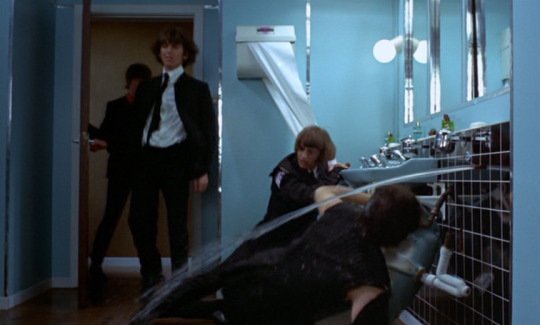
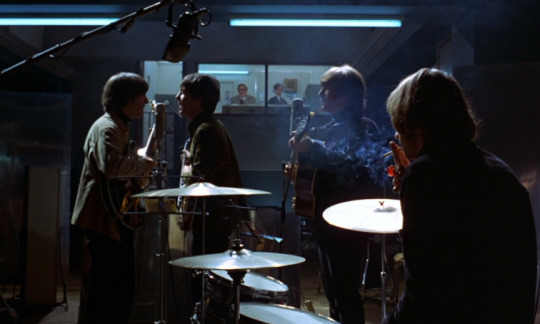
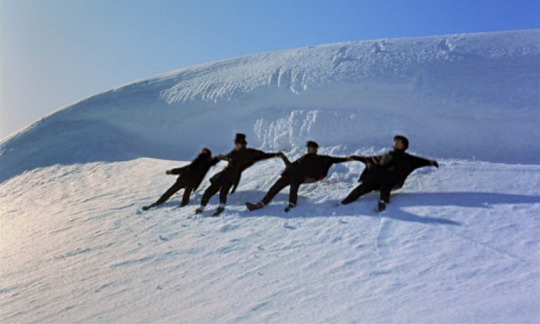
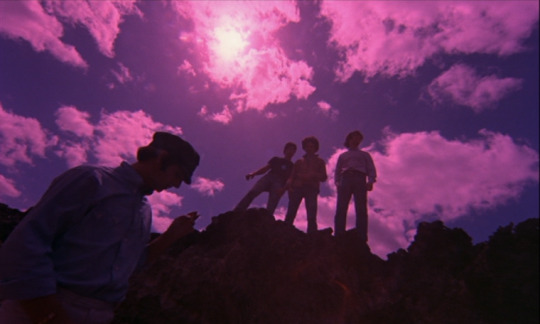
"It's a different religion from ours. I think."
After A Hard Day's Night (Film)'s smash hit, the moviemaking machine's wheels were already turning for the second of their contracted 3-Pictures deal with United Artists. This time they had about twice as much budget, but the Boys were already feeling the strain of their fame, and didn't particularly enjoy the process in the last film. As part of their new fascination with Weed, and perhaps a grasping for some way to rebel, they went into this project while high as four fruity kites.
Naturally, this made it harder to film, as they'd forget lines and get into lengthy giggle fits. However, the end result is enhancing the existing Deeply Unserious nature of the film, so as someone who didn't have to herd them around I find it very enjoyable. But yes, it's still a stupid movie. But, it brings me joy~
BUG ACTING
With all the Bugs being baked, it's a little harder to rate their acting skills, and it ain't always clear if they are indeed acting or are so out of it they're forgetting the cameras are on and they're just reacting as they would if it were real. This is advantageous for Paul, at least, and on the whole I would say they do well considering. I do have to question the group's overly long and weirdly smooth hair in this one, though.
The supporting characters are obviously sober and offer strong performances, like Eleanor Bron as the double agent Ahme, the most competent character in the story by far, and Victor Spinetti in his Evil Scientist role of Foot. The cult leader, Clang, is surprisingly charismatic and sometimes breaks the fourth wall to muse to the audience if it'd be easier to get youth interest through other means, before continuing with the murder plans. Other recuring characters like the Assistant Scientist and the Cult Member who's always getting hurt, and the Superintendent with the Famous bit mean there's always something going on no matter which group the focus is on.
PLOT
In something of a prototype Austin Powers plot, the story revolves again around Ringo, who's been gifted with a special ring that he can't take off which makes him the target of a crazed cult. Taking shots at the imperialism of James Bond and on organised religion both, the story leads The Beatles on a short world tour as they also sing a few songs and get increasingly annoyed by the magnetic danger.
This movie, being made in the mid-60s and following similar international spy thriller cues, is a little bit racist. Possibly the least racist 60's movie (AHDN, MMT and YS are a bit less though lol) but the Cult in this are Indian Flavoured, albeit with the deliberate swerve of the goddess they worship being Kaili (not Kali of Hinduism) and the comparisons with church groups, that they aren't so different. I don't want to sound like I'm making excuses for the film, or just waving it off as the style at the time, but I've seen other films from the same era and they are DREADFUL about Ethnic Villainy so like, pick your battles lol. This one at least feels self aware about it. And it was the foot in the door that got George (and by extension, the others) interested in the culture.
SCRIPT & SUCH
Like AHDN before it, there's a lot of witty bits of dialogue, this film particularly indulges in bait and switch, and double entendres. For an example, in the part when they're about to try shrinking Ringo's finger with a syringe of magic science, Paul asks if it's habit forming. George [who's unwrapping a stick of gum at the time] says "No, as long as you don't swallow it." Stuff like that is all over the movie and it's fun, but again a bit hard to catch it all on the first watch.
There's also plenty of fourth wall breaks and little foreground/background events occuring, e.g. George casually stealing from the Jeweler's shop, and again, instances where the Boys were obviously high on set and seem to be spacing out or overdoing it. It's a shame that Paul and Ringo running off into the distance (to go smoke more) after shooting a scene wasn't filmed, as it sounds hilarious and wouldn't be any stranger than the rest of this movie.
There's also a lot of obvious ADR, and it seem the Bugs were still heavily medicated when doing these, as the apathetic, flat "Hohohohoho" as they Beatle Sandwich on a toboggan and the misc. grunts they make with the hand dryer are the sort of thing you'd think would get junked for a retake, but maybe Their Power was enough to mean the first takes were used as they have busy schedules? I think it enhances the film's Vibe, though.
MUSIC
The crown jewels of Help! for me, other than the capering about and Silver Age Comic flavour, are the music videos. In glorious colour, in new and interesting locations, and even with more dynamic and creative camera angles! With 7 of the stronger songs from the Help! Album (though tragically missing Act Naturally...), the stand outs to me being You're Going To Lose That Girl with the studio bathed in beautiful smoky colours, and Ticket To Ride, set against the late afternoon Austrian ski slopes [with bonus Train sighting! 😎]. These are almost worth the admittance fee on their own!
It's also possible that the Boys were saving all their Acting Power for the video sequences, as half these settings were cold as hell (even The Bahamas, where they wear summer clothes, as it was filmed in Winter) and they manage to power through haha
Other than the full songs being played, there's a lot of reconizable tunes as incidental music, like A Hard Day's Night [both on Sitar and as background music in The Bahamas], what sounds like a snippet of I'm Happy Just To Dance With You, and some classical music not written by The Beatles!
FINAL THOUGHTS
As I said in the preamble, it's plain ass a stupid movie. But yet, it's witty...! On the whole, it enchants me with its whimsical swag and I can't help but to grin at the antics shown here~ Still, I would say A Hard Day's Night objectively has it beat in most aspects, including social commentary, as AHDN's layers are more nestled in and solid.
I'm ranking it 2/3 too, just for different reasons. Pros include the colour, the wonderful videos and the "tehe" factor, as well as a Diesel Loco being very visible in Ticket to Ride. But even at my most biased I give AHDN the Better Movie title. Still I feel this one is underrated and worth watching for all Beatlemaniacs :3
🪲🪲🪲🪲
I'm undecided what next month will be... the options I have in mind are the worst "movie" or what I consider to be hands down the very best! That means MMT vs Yellow Submarine. I'd go with MMT first due to release order, but quite frankly I don't know if I can make its writeup long enough XD;;;;
5 notes
·
View notes
Note
PLEASE PLEASE PLEASE HAVE JEAN GIVE MARCO A PUNK/ALT MAKEOVER ! HE NEEDS A SEPTUM THAT HE CAN HIDE FROM HIS PARENTS
OH DONT YOU WORRY I WILL DO THAT!!!!
I love that idea so muchhhhhhh i may ramble a bit abt this AU-
I like to think in this AU Marco has strict parents inspired by the spoof panel when he’s like “titans are scary like when your dad gets mad at you for doing something wrong, ghosts are scary like when your mom gets mad at you for no reason!” (I’ll have the pic in the end!)
So they’re just overly worried about Marcos future, strict as hell with appearance, school work, etc. When they find out Marco is hanging out with “that little punk” they’re NOT happy about it!!! But that’s not stopping Marco from hanging out with him!
In my recent art Jean is the one who gives Marco his lobe piercings. Marco did NOT tell his parents that Jean was the one to do that. Heck they didn’t even notice the piercings right away it took them like a week. When they saw and freaked out he told them he got them done at the mall. They didn’t force him to take them out but they didn’t want him getting any more piercings.
That made Marco want more.
So jump forward a month or so he asks Jean to help him find a place to do his septum. He learned that you can hide a septum by flipping it so it shouldn’t be too hard to hide from his parents. Jean teases him being all “omg you’re turning into a little punk like me!!!” “I’m so flattered that you look up to me and my “bad ways” Marco!” “Your parents are going to ban you from hanging out with me if they ever find out”
After getting his septum, he not-so-slowly becomes inspired by Jean and his whole appearance starts to become more alt…I swear I’ll draw this soon!!! Sorry I’m rambling thehehe I love these idiots so much. Jean inspiring Marco to become more free with self expression- UGHHFJSJA

4 notes
·
View notes
Text
Agatha All Along - Season 1 Review

*spoilers ahead*
So I finally finished this series and I almost wrote a review after episodes 1 and 2, but felt this was a show that needed to be completed and have me marinate on for a bit.
I won't go too deep into the series or do a blow-by-blow of each episode and character, but I will say that this was one of Marvel Television's better live-action series. And this coming from someone who is "supposedly" not the target audience, which I think is total bullshit when it comes to media consumption. Most protagonists on-screen are not me (or you for that matter). Maybe there's a shared gender, ethnicity, culture, sexuality, etc., but a good story is a good story. Yes, it can be more engaging if you can see yourself in the characters on-screen and representation DOES matter, but again... give me a good story with good/complex characters or just something enjoyable and I'm in.
First, I appreciated that this series solved what I've perceived as Marvel/Disney's biggest problem with a lot of their shows the last few years, and that's pacing. Most Disney+ shows, even non-Marvel ones, have felt like long film scripts that were chopped up and extended for a 6-10 episode series, with writers/showrunners who don't understand series storytelling. Good beginning episodes, slow paced middle, random side plot/non-plot episode, and a rushed ending.
While some of the reveals in this series weren't necessarily shocking (thanks in part to some spoilers I accidentally saw online), I will say they were well done and the writers knew how to weave all the plotlines together for a satisfying story. If anything, I'd say episode 1 was the weakest episode, which is a hard start for a series (especially in trying to appeal to a general audience for a spin-off show), but going into the show knowing that it was about witches and not a re-hash of the WandaVision different TV show settings schtick, I was able to endure the whole dark crime drama show façade until it was torn away. That said, episode 1 wasn't bad, but the delivery was inconsistent at times. Obviously, this was later explained as the rest of Westview just going along with Agatha, but as a viewer it was hard to tell if Kathryn Hahn and the other actors were spoofing dark crime shows like 'Mare of Eastown' or trying to give a genuine performance like in WandaVision. It also didn't help that when Hahn and others were going a bit over the top in their acting I kept thinking about the Murdur Durdur SNL skit, which then took me out of the story. Thankfully, this stopped within episode 1 and episode 2 took us into the main story. So I say, good call in releasing episodes 1 and 2 together.
The rest of the series after episode 2 did follow a similar format to WandaVision, where each episode was a new setting with new costumes, but unlike WandaVision I felt like that gimmick never overstayed it's welcome. In WandaVision, the new TV show thing became repetitive about halfway through the series, but I stayed for the plot nuggets that dropped along the way. For 'Agatha', while each episode was a new "locked room" type experience, I think having the ensemble cast helped keep it fresh. Each character got focus, the story unfolded naturally, plot points were revealed throughout the episode rather than teased as a way to come back for the next episode, and the stakes seemed to get higher with each new trial. Basically, each episode was a self-contained story while also being part of a larger series arc. Series Writing 101. Thankfully, someone at Disney/Marvel finally understood the assignment.
I loved all the different characters in this series--the coven--and I was sad when most them didn't make it. So even despite each episode having some sort of themed gimmick it never felt like it was doing stuff for the sake of the gimmick or fan service, not to mention the big reveal in the last two episodes about the Witches' Road. Again, hats off to the writers for Keyser Söze-ing us (IYKYK) while also showing how myths, legends, or lore can form over time from the simplest of stories told around a campfire (or a fun little song between mother and son). And yeah, that song is catch as hell. Unfortunately, I'm also not someone who can memorize song lyrics, so it's just, "down, down, down the road. Down the witches' road." on repeat in my head. Thanks, Agatha.
Also, I'm glad Disney/Marvel committed to the LGBTQ+ representation on-screen. I know it's not the first instance, but the studio has gotten it's criticism in the past for queerbaiting. After all, Deadpool is on the app now so there's no going back. Plus, if you didn't know Agatha and Rio/Death had a past in episode 1, I don't know what to tell ya. I'm a cishet dude and I got it. Then again, Aubrey Plaza is always a good casting if you need an actress who looks like they might want to kill you, fuck you, or do both. And I mean that in the most complimentary way to Ms. Plaza. Hahn also did great and it was fun seeing her really chew the scenery as Agatha, while also knowing when to dial it back to let the other actors shine. Again, a great ensemble (Joe Locke, Sasheer Zamata, Ali Ahn, and Patti LuPone. Not to mention Debra Jo Rupp--poor Mrs. Hart).
Overall, I enjoyed this show. It was a perfect watch for spooky season. It was fun, heartfelt, and I enjoyed the whole cast. I know there are those who probably have deeper analysis/critique regarding witch and/or wiccan lore, magic, tarot, and the different trials each character faced in this series, so I hope you find those posts as well. I know I'll be interested in reading them as they pop up.
3 notes
·
View notes
Text
Some movies, considered chronologically:
THE FLAMINGO KID (1984): Nostalgia-burdened period piece, set in 1963, about working-class kid Jeffrey (Matt Dillon), who gets a summer job parking cars at an exclusive beach club called El Flamingo, starts dating a rich girl (Carole R. Davis), and becomes fascinated by her father (Richard Crenna), a self-made sports car dealer and local card sharp who thinks college is sucker's game. This alienates Jeffrey's own father (Hector Elizondo), a stalwart plumber who doesn't want to see Jeffrey squander his chances of bettering himself. The story is thus a sort of YA prototype of Oliver Stone's later WALL STREET — a Reagan-era morality play about a young man caught between two father figures, one representing the Lure of Easy Money and the other a paragon of Honest Hard Work — badly undermined by its absurdly idealized longing for the alleged innocence of the Kennedy era (underlined by an obnoxious oldies soundtrack). It offers a meaty role for Crenna, but as a drama, it has less substance than FERRIS BUELLER'S DAY OFF. Davis's character is such a nonentity that you keep forgetting she's there, and the way she ends up functioning as a proxy for Jeffrey's obsession with her dad is awkward. CONTAINS LESBIANS? Nope. VERDICT: A simple-minded story blinded by its rose-colored glasses.
THE JOY LUCK CLUB (1993): Sudsy but affecting episodic adaptation of Amy Tan's novel about four middle-aged Chinese women and their strained relationships with their Chinese-American daughters, starring Ming-Na Wen and nearly every other Chinese actress working in the U.S. at the time. The way the script segues between the characters' respective stories is clunky, and it often teeters on the brink of schmaltz, but there are moments of real dramatic power amongst the more superficial tearjerker moments, and you'd have to have a stonier heart than I to not sob at the bittersweet ending. Strong acting helps, with Tsai Chin particularly good as Auntie Lindo. CONTAINS LESBIANS? It seems like it should, but alas. VERDICT: Heavy-handed at times, but undeniably moving.
COLD COMFORT FARM (1996): Before she became an action star, Kate Beckinsale starred in this hilarious adaptation of Stella Gibbons' 1932 satiric novel about glib orphan Flora Poste, who makes it her project to fix all the problems of the titular farm and its eccentric denizens — distant cousins who feel obligated to Flora (whom they will only address as "Robert Poste's child") because of some unspecified wrong they once did her late father. Among the inmates of Cold Comfort are Cousin Judith (Eileen Atkins), a hysterically morose creature straight out of a gothic novel; Cousin Amos (Ian McKellen), a fire-and-brimstone preacher who warns his brethren, "There'll be no butter in Hell!"; Amos and Judith's oversexed son Seth (Rufus Sewell), a local stud who dreams of being in the talkies; and of course Aunt Ada Doom (Sheila Burrell), who rules the family with an iron fist and won't let anyone forget that she once saw something nasty in the woodshed. A delightfully silly spoof of a particular category of once-popular English literature, as the farm's assorted grim melodramas prove no match for the implacable (if somewhat snobbish) modern sensibilities of its plucky heroine. CONTAINS LESBIANS? Nope. VERDICT: Great fun throughout, although Stephen Fry irritates as a boorish "Laurentian person" who keeps hitting on Flora despite her obvious disinterest.
BREAKDOWN (1997): Competent but underwhelming Jonathan Mostow thriller starring Kurt Russell and Kathleen Quinlan as Jeff and Amy Taylor, a couple of Yuppies whose fancy Jeep breaks down on the highway on a trip from Massachusetts to California. A passing trucker (J.T. Walsh) gives Amy a ride into the nearest town to find them a tow truck, but when Jeff gets their Jeep running again and follows her into town, he finds that Amy has disappeared, and no one, including the trucker, will admit to having seen her. It has a great premise, and Russell is credible enough in the lead, but it's pretty ordinary, and, once you know what's going on (which is revealed a little over a half-hour in), pretty superficial — there's no psychological depth, and I kept waiting for some other story twist that never came. CONTAINS LESBIANS? It barely contains women (Amy is absent for 80 percent of the running time). VERDICT: Not bad, but nothing special, and you'll forget it 10 minutes after it ends.
MY TWO HUSBANDS (2024): Okay Lifetime thriller about a young woman named Eliza (Isabelle Almoyan), still reeling from the recent murder of her mother (Joanie Geiger), who becomes deeply suspicious of her father's young new wife, a flight attendant named Brooke (Kabby Borders) who's no older than Eliza — and, as the title alludes, is secretly married to another man (Britton Webb, who looks like a lesser Baldwin brother) and up to no good. Despite the cheesy title (which is really also a spoiler) and awkward marketing (which misleadingly suggests a comedy-drama with Brooke rather than Eliza as the main character), it has a surprisingly decent, reasonably credible script, hamstrung by very weak performances. The story is still interesting enough to make it a not-bad little thriller, although it would have been better with a stronger cast and less somnabulistic direction. CONTAINS LESBIANS: It sometimes seems like Eliza's friend Star (Kristen Grace Gonzalez) might be her girlfriend, but the script is noncommittal on this point. VERDICT: A B+ script burdened with D+ acting and C- direction.
#movies#hateration holleration#the flamingo kid#matt dillon#richard crenna#the joy luck club#amy tan#ming na wen#tsai chin#cold comfort farm#stella gibbons#kate beckinsale#ian mckellen#rufus sewell#breakdown#kurt russell#jt walsh#my two husbands#isabelle amoyan#kabby borders
3 notes
·
View notes
Text
UNDER THE SURFACE
MEET THE CHARACTERS : 1

Lola || They / Them
Ah yes, my Splatoon 3 character, my autistic little baby. Small and agile, Lola is an unexpected case, being extremely strong for their size. Lola is an optimistic inkling, trying their best to find the good in every situation, and reassure those who aren’t so sure there is any. They are amazing at comforting people, and they care deeply about everyone around them. Everybody likes Lola. Other than that, Lola is a fairly chaotic individual, parkouring to the top of high buildings, sometimes to paint the landscape, and getting into trouble with their friends often. They can follow the rules when needed, but they don’t mind a little bending of them.
Lola is 17 at the start of the main Under the Surface story ( UtS ). Before then, Lola grew up in a smaller part of Splatsville before people started migrating to the city. Growing up as an only child with their parents, Lark and Aiden, and their best friend Clyde, they had a pretty stable upbringing. Though they struggled with bullying throughout their childhood and continue to struggle with their self image, they keep their positive front, and it helps them get through life. Lola’s family was a rare team of three, and would often participate in very small scale Turf Wars. At 13, Lola and Clyde started drifting a little, before Clyde completely disappeared one day, abandoning Lola. Once they gained their humanoid form at the normal age of 14, they moved out into the bigger part of the city, determined to start making a name for themself in Turf War and Anarchy. They found a job at the Lophelia Art Museum and started climbing the ranks. Around this time is when they found the crater, along with an inkling named Razor and his small fry Spoof. Lola gets roped into the New Squidbeak Splatoon as “Agent 7”, and the events of Splatoon 3’s story play out, thought slightly modified. After defeating Mr. Grizz, Lola returns to their normal life, meeting their future friend group one by one. Among these are Rion and Phun, which end up becoming two of their best friends ( they might be a little gay who knows ). Lola gets up to some things in the 3 years before UtS, but that’s for a later story.






God they are so silly I love them so much
#splatoon#sploon#under the surface au#lola uts#splatoon au#Splatoon 3#I love my OCs so much ough#I can’t wait to traumatize them
9 notes
·
View notes
Text
DisneyFormers AU- general premise/concept
A plethora of different Disney characters suddenly start turning into protoforms and are being mysteriously teleporterd across several universes and timelines to Earth many years after the end of Cybertronian War…
Autobots
After the end of the War, most autobots settled on Earth and continue to protect the Earth and its inhabitants. Optimus Prime has stepped down from being the leader of Autobots, focusing on working as firefighter and raising his and Elita One’s sparkling. Autobots work closely with G.I. Joe, protecting the Earth from its every corner. When several of Disney character protoforms fall to the surface of the Earth, Autobots make it their duty to help and train them to become seld-sustainable as bots. And make sure they don’t fall victim to the Villains…
Decepticons
After the war, Megatron is still unable to come to terms that the Allspark is gone. He has stuck in place for many years at this point and is unable to move past that and go foward.
Many Decepticons, frustrated with their leader’s inability to leave the past behind, abandoned the case and moved foward, taking jobs among humans, joining Autobots or just living their best lives on Earth. Nemesis, still orbiting around the Earth, is an interesting place. What used to be a warship, now became a cozy quarters for the remaining Decepticons who have moved on with their lives and Megatron.
The things especially shake up, when an unusual protoform bot is found in the void of space above Earth. Especially it gets interesting for scientist Shockwave…
Disney Heroes
Several of Disney characters suddenly start turning into Protoforms and are flung across several universes and land on current timeline of Transformers universe. This AU mostly follows the shenanigans of one particular group of characters that crashlands in the middle of Nevada desert (with exception of one) (I'll separate them into groups here, according to the movie they're from. Sorry for stupid of those). It consist of:
Cinderella Gang 👠✨ (After the events of Cinderella III: A Twist in Time)
Cinderella, aka. Cindy/Cinder- transforms into an adventure bike. Her little animal companions are always with her built-in pockets. Her default weapon of choice are shurikens that always come back to her, but also uses help of her smaller friends
Prince Charming, aka. Henri- transforms into Zarooq Sandracer spoof. Uses a lightsaber-like fencing sword with built-in plasma shield
Anastasia Tremaine- transforms into Formula 1 bolid (she actually scanned the vehicle by complete accident, but stayed with it). Her weapon of choice are yoyo-style chained
Cinderella's companions
Jaque and Gus- Cinderella's pocket mice companions. Combined, they turns into self-defense long-distance taser for Cinderella. When on their own, they transform into small RC cars.
Bluebirds- Cinderella's pocket bird companions. They transform into two small spying drones capable of recording hours of voice transcription
Bell tower Gang 🔔⛪
Quasimodo- he is a triple changer. Transforms into Boeing Chinook spoof chopper and a SWAT tank. During his time in different world, he picks up a hobby in Dungeons and Dragons and picks up a job of creating custom D&D figures. Suffers condition where the chopper kibble heavily concentrates on one side of his back (reference to his hunch), causing problems with balance. His weapons of choice are "Mantis Shrimp" gloves.
Esmeralda- Transforms into Cadillac Eldorado cabrio model car. Her weapon of choice is a pair of chackrams she hides in rims of her car mode. She also has a small self-defense non-lethal blaster. Frequently accompanied by Djali
Phoebus, aka. Phoebe- transforms into Ford Interceptor spoof. During his time on different timeline he picks up a job of policeman in Nevada police department, paired up with Barricade, a former Decepticon deserter, as colleagues. His weapon of choice is a crossbow-style heavy gun.
Clopin Trouillefou (oh boy, a fruity one)- transforms into Harley Davidson Trike spoof. His weapon of choice is unconventional, as it's a sentient sniper rifle called Stitches (his handpuppet in HoND universe). He also uses a large energon scythe for close combat. One of his special abilities is using his foot wheel kibble as roller skates. He can also join his legs together for stable riding in straight line ridiculously fast when sharpshooting mobile targets.
One-offs
Lars (from 101 Dalmatians: Patch's London Adventure)- doesn't transform into anything in the beginning. He's technically not a Transformer as he lacks a functioning T-Cog. Instead, he's a sub category of sentient robots closely related to Transformers- Energeticon (they're capable of holding large sums of pure energy in relatively small bodies thanks to their mutated sparks). Unlike the rest of heroes, he's actually found and rescued by Decepticons andresodes on Nemesis, working as close assistant of Shockwave. Or maybe he's more than just Shockwave's lab assistant...
Bradley Uppercrust III (from An Extremely Goofy Movie)- transforms into Jaguar XJ220 spoof. His special gimmick with him is that his kibble is completely detachable and detached kibble transforms into a hoverboard. His weapon of choice is a pair of hook swords
Matsuda Kaito, aka. Clio (original character, tied to HoND universe)- Clopin's distant relative (half Roma, half Japanese). Transforms into Shotaro Kaneda's iconic bike from Akira (he scanned the bike during its tour across US). His weapon of choice is energon Nagitana.
Author's comment about Clio
"I really just want to talk a bit about Clio's backstory. Clio is a rebellious teenager from Azuchi-Momoyama period of Japan. He is considered a hot bad boy by today standards. In reality, he's a young adult frustrated with living as a son of a samurai and is scared of bearing responsibility as a warrior in near future. Even his choice of weapon is considered unworthy of a samurai by his father. Clio even hates being referred to with his real name. When landing in world of Transformers, Clio feels very free inside. He also has opportunity to be with Clopin- a distant relative he is very closely bonded with and could only exchange letters until now. He also realizes that he has very deep feelings for his teammate, Bradley Uppercrust III. This experience is opportunity for Clio to grow emotionally and prepare for his inevitable future as a samurai."
.
.
.
.
.
.
And it's that for now. I'm going to post more about that in the future and give potential story bites in the future and reveal the Villains soon. Stay tuned!
#disney#transformers#au#alternate universe#crossover#proof of concept#original idea#the hunchback of notre dame#101 dalmatians#cinderella#an extremely goofy movie#disneyformers#transformers fan continuity
4 notes
·
View notes
Text
My sophomore year of high school the spring musical was The Little Mermaid and it was great but the best part was the crew (me) writing an entire new show called "stage crew: the musical" and it was just a normal shoe except the set was flipped so the back was facing the audience so you could hardly see the actors but the crew was visible and we were the ones with microphones and it was just us spoofing off of the show the whole time (as stage crew does) panicking over props and costumes and tech (as we do) and occasionally there would be a music number in which the actors were all frozen. My favorites included:
"Under the Boat" it was Under the Sea except the crew had to move the boat off of the stage while the lights were still up so we had to chill underneath it for the entire opening number. One of us punched an exposed screw on opening night. We made hats dedicated to this song.
"Trapped in the Tower" we don't have enough mics for each actor to get their own so they have to share. In one particular scenario, flounder had a line and immediately the next scene Ursula was wheeled out in her tower and needed to use that same mic so one of us would climb up there to help her because her gloves were ridiculous and if we weren't fast enough to scurry off before blackout, we had to curl up into a ball and pray we weren't visible
"Ooh Girl Don't Date Your Castmate" self explanatory
"I'll be Dead by Tomorrow (at the Hands of Bubbles, You, or Myself)" we had bubbles for Under the Sea and everyone kept slipping on the residue. This is especially during blackouts when the crew had to run on and retrieve them and run back off while a new backdrop came down. The guy lowering the backdrop couldn't see us so he would often hit us.
"Glory on Our Own" basically the crew didn't get to bow during curtain call so we would stand in the wings and bow to each other
2 notes
·
View notes
Text
Writeblr intro 💙⭐️💜

Flies into open window through helicopter wire and front rolls across room.
Wait, wrong window.
Repeats everything but into the correct window where you’re standing and magnificently introduces myself for the first time.
Hey~🕺🪩
A bit of backstory for this account. (Feel free to skip this and go straight into the intro below):
I made this blog ages ago to try and connect more with self shippers, but I ended up not doing anything with it because I became inactive in the self ship community (at least until now. I might make a separate blog for that later, but right now I’m focusing on some more important things in my life).
So I tried reforming this place into a “I’ll put whatever I want here” sorta thing, but once again became inactive. And now that Instagram (my main platform) has basically been rendered useless because of the tags not working anymore, I need to find a new “main” to talk about my writing and shit. So I’m trying for a third and hopefully final time to reform this blog, and turning it into a writing/oc blog. :b

✨✨✨
About me:
✨✨✨

🛸 My name is Rosalind B. Sterling, but you can call me Ross or Ros.
🛸 My age is—slowly looks up at the number twenty looming over me. Dear god. It’s coming.
🛸 I’m a college student. Or at least I’m supposed to be. If my school would just make the transfer process a bit easier, I’ll hopefully be able to make it this semester.
🛸 I’m a demibiromantic asexual, and genderfluid. My pronouns are she/he/they 🏳️🌈🏳️⚧️
🛸 I’m Puerto Rican, German, and Scottish.
🛸 I’m also neurodivergent.
I mention all this because I want everyone to know that this is this is a safe space for LGBTQ+, POC, disabled people etc, and I love using my experiences as a person from these groups to write diverse casts of characters into my books.

✨✨✨
About my writing/what to expect from this blog:
✨✨✨
💜 I'm an author/writer, editor (mostly developmental), artist (mostly cartoonist), and reader who posts illustrations, writing content, book reviews, discussions, thirst traps of sexy characters 💅, and more. See? You get an enjoyable variety of content here ✨
💜 I primarily write adult oriented stories in the genres: crime, comedy, and sci-fi, while mixing in vintage/nostalgic elements from different time eras ranging from the 1920’s to the 2000’s. I also love playing Cupid and slipping in different romantic subplots with varying levels of spice.
💜 You’ll probably see a lot of morally gray characters, cartoon-style humor, a chaotic/meta writing style with 4th wall breaks, and lots of parody/spoofing in my stories.
💜 I’m a planster, and often don’t know what the hell I’m doing when I write. I just shit something out and shape it into something readable with the help of my many betas and editors who still somehow put up with me to this day (I love you guys).
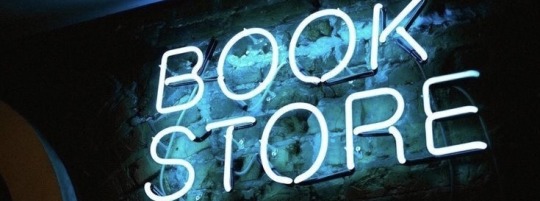
✨✨✨
What do I read?
✨✨✨
I like to read what I like write, except not everything I like to write is available in the book world. So at this point, I’ll read anything as long as it holds my attention for more than a few chapters.

✨✨✨
Can I read anything of yours right now?
✨✨✨
⭐️ Yep!
My debut novel: "Villain vs. Villain and the Revitalization of the Transtemporal Case" is the first book in my illustrated, crime/comedy/sci-fi trilogy. It's currently on Amazon in ebook format, and on Goodreads. But I’m also in the works of getting the paperback out this month as well as the animated-ish book trailer.
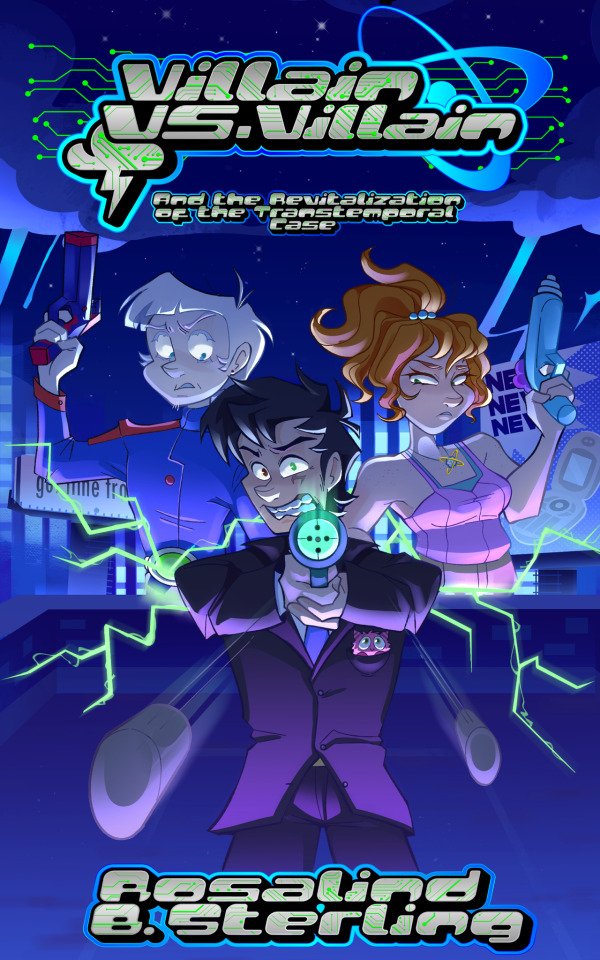
It’s a story about a time travel scandal taking place in 2005. Jonathan, a black market salesman, is on a journey to clear his name and stop his brother from messing with the timeline. Along the way, he teams up with an undercover agent and go on wacky adventures together as they attempt to reach their goals and hopefully put a stop to their dimension’s demise.
⭐️ I also have a few random short stories on my website blog which can be found here, however, I’m highly considering re-working them as they are all unedited, probably full of errors, and I also wrote these anywhere from months to years ago, so I don’t think they properly represent my current writing all that well.
⭐️ Honorable mention to my Webtoon which you can find here. I haven’t posted anything yet, but have plans to do mini comics with the characters of my Villain vs. Villain trilogy as a way to explore ideas and backstories I couldn’t explore in the books themselves.
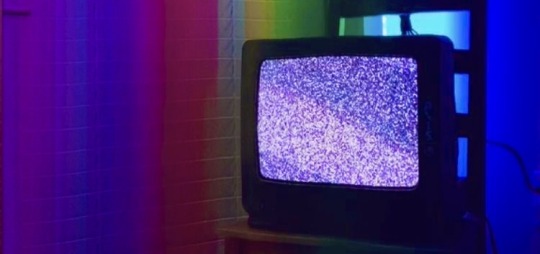
✨✨✨
Do you have any WIP's?
✨✨✨
Distant screaming.
Too many my friend...too many. But my main WIP right now is book 2 of my Villain vs. Villain trilogy. I also have a 1920's crime/comedy/sapphic romance short story thingamajig I've got in development that I hope to publish next year. I simply don't have the time, money, or energy to publish book 2 next year as I originally planned, so hopefully this short story will fill in that publishing gap until I get my trilogy figured out.

✨✨✨
Some random facts about me:
✨✨✨
💙 I love anything Y2K, scene, noir, neon, synthwave, cyberpunk, etc. You name the aesthetic, I probably like it. (I have waaaay too many eclectic interests and styles so I’ll probably look different in every photo, and I’m putting my bets on it that this account won’t have a concise theme either).
💙 I have a shih tzu/writing partner named Dakota who will sometimes appear on my account. (He loves contributing to my drafts by jumping onto my lap and slamming his paws and ass on my keyboard). Also ignore the half destroyed chair he’s sitting on. He’s responsible for said destruction and is proud of it.

💙 I currently live in Ohio, and yes, I can confirm first hand that it’s an entrance to the backrooms. The screams from outside keep getting louder too…
💙 Horror is my comfort/self indulgent genre. I would say the same about erotica but I really can’t seem to get into most books I find in that genre for some reason. So I mostly read shitty X reader fics online involving the characters I crush on (who totally aren’t cartoon men in their middle ages).
💙 Music is one of my biggest inspirations for writing. My favorite genres are 2000’s-2010’s pop music, and electro swing. My favorite artists are: Lady Gaga, Britney Spears, Pitbull, Wolfgang Lohr, Swing’it, and more.
💙 I talk…a lot…as you can tell by the length of this blog 🌝

✨✨✨
Welp, that’s all I got for now. I’m still working on reforming this blog, as I said earlier, so there might be a mess of random posts here here as well as an unfinished theme until I figure how the actual hell to use this platform. I sorta wanna post both orginal and fan content like I was doing before, but whenever I dedicate an account to my writing, I feel odd posting anything that’s not OC related. We’ll see what happens.
In the mean time, check my link tree for my other socials, website, and my editing services. If you follow this blog, I’ll most likely follow back because I need friends lmao. No matter your age, the genre you write, where you love etc, come say hi. I really don’t have restrictions on what kind of audience I want since I love everyone and wanna connect with as many writers/artists as I can. Hit up my DM’s too if you wanna chat. I’m always open to have a nice convo.
And with all that being said, welcome to my blog raaahhhh 🦅
Jumps out of window and dies.

#writer intro#author introduction#writer introduction#author intro#writerslife#writer blog#writeblr#indie writer#queer writers#trans writers#queer author#trans author#artist#meet the artist#meet the writer#meet the creator#published#published author#published writer#amazon author#kdp#debut author#writers on tumblr#searching for wrierblrs#creative writing#writing community#writer things#scifi writing#crime writing#comedy writers
2 notes
·
View notes
Text
Stars shimmy down Hudson’s ‘spirit tunnel’
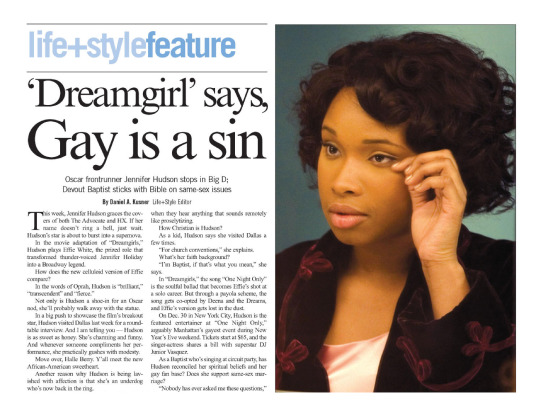
Clips with customized hype songs for talk show’s guests create sensation online
Jennifer Hudson dances March 27 with the staff of “The Jennifer Hudson Show” in the “spirit tunnel,” which leads to the studio in California.
Guests also make their way down the hallway before taking the stage.

I have never watched an episode of “The Jennifer Hudson Show.” Yet here I am at my desk, singing to myself: “Aaron. Pierre. That’s Mufasa.”
If you’re familiar with the tune, you’re singing it now, too.
If not, picture Pierre, the dashing actor who voiced the title character in “Mufasa: The Lion King,” strut-dancing his way down a hallway.
“The Jennifer Hudson Show,” a daytime talk show, is not a top-syndicated program, according to the ratings agency Nielsen.
But it has amassed a huge social media following with its behind-the-scenes promotional videos.
Before taking the stage, guests make their way down a hallway as members of the show’s staff serenade them with a complicated, customized hype song, sung entirely from memory.
Some of the biggest names in American culture — Michelle Obama, Usher, Angela Bassett — have danced, skated or nervously shimmied through this “spirit tunnel” as the TikTok cameras roll.
Some of the videos are awkward.
Some are suave.
Most go viral.
During the show’s first season in 2022, members of the show’s staff learned that cheering for Hudson before she took the stage boosted her confidence and energy.
“It provides that moment to connect, release any preshow jitters,” Hudson said in an email.
And if it could help Hudson — an actor, singer and EGOT winner — surely it could help her guests, too.
So in January 2024, Angie Green, a producer, and Alexis Powell, an associate producer, took on a new duty: writing and choreographing a personalized song for each guest to walk out to.
Immediately after a guest is booked, the process of composing a spirit tunnel song begins in a group chat with 15 crew members.
Like a rapper coming up with a clever dis track, the staff members research the guest’s past — analyzing a singer’s discography, for instance, or digging up an obscure cultural reference from an actor’s life.
It helps that many staff members are self-described theater kids, with backgrounds in music and dance.
Powell said the team’s brainstorm for comedian Kevin Hart went something like this:
Kevin Hart is from Philadelphia. Rapper Meek Mill is also from Philly, so maybe we could spoof his popular song “Dreams and Nightmares.”
But that’s too wordy. And
not very dance-y. Hmm.
I just saw Hart dance to “Just Wanna Rock” by Lil Uzi Vert, another Philly rapper.
Maybe that’s something?
What they ended up with was a song about how happy they were to see him, sung to the tune of “Just Wanna Rock.”
In the video, which has 70 million views and counting on TikTok, Hart feigns surprise as he is greeted by the line of staff members. “Feelin’ it!” Hart seems to say as he dances in the hallway.
Each tunnel moment is different.
Usher roller-skated down the hall to a spoof of his song “Yeah!” The video has 40 million combined views on TikTok and the social platform X.
The video featuring actor and former Disney child star Brenda Song has more than 110 million views on X alone, in part because of her jeans, which flare at the knees and resemble car wash mops.
The popularity of the spirit tunnel shows how reaching an audience online has changed over the years. Andy Lassner, an executive producer of “The Jennifer Hudson Show,” used to work for “The Ellen DeGeneres Show.”
In the early days of social media, he helped DeGeneres dominate on YouTube with elaborately produced videos that received tens of millions of views, such as when Lassner yelped his way through a haunted house with Ariana Grande.
But a decade later, as everyone is trying to generate social media hype, the best way to grab attention is often to capture a spontaneous moment.
By preparing for hours each week, the staff of Hudson’s show catches guests off guard, prompting genuine, unrehearsed reactions that people on TikTok find irresistible.
The tunnel videos caused a sensation for the first time in October 2024, and it happened almost by accident.
The crew, who had been singing tunnel songs for guests for nearly a year without filming them, decided to roll the cameras as Gwen Stefani danced through a spoof of her song “Hollaback Girl.”
She fully committed to the bit, twirling and twerking up and down the hallway.
The video worked its magic on TikTok, collecting 40 million views and counting.
“We didn’t know how she was going to react,” Powell said. “She was hyped. It was just a great day.”
These days, guests on “The Jennifer Hudson Show” know the tunnel walk will likely be the most-viewed segment of their appearances.
So how do you keep something fresh when everyone is expecting it? New lyrics. New tunes. New references. The crew learned to say “hello” in Korean — “annyeonghaseyo” — for Lee Jung- jae, the South Korean “Squid Game” actor, and the earnest shock on his face perhaps contributed to the popularity of his video (120 million views and counting).
Keke Palmer’s improvising with the crew helped her tunnel video reach nearly 40 million views on TikTok.
Not all guests are game, however.
Noah Wyle, of Max’s “The Pitt,” recently declined to participate, citing bad memories of a failed execution of the worm at a bar mitzvah in 1984.
Of course, the spirit tunnel videos — which the show’s publicity manager says have been viewed a total of over 3 billion times — don’t guarantee long-term success for the program.
“Going viral on TikTok is not going to fund your multimillion-dollar show,” said Freddy Tran Nager, an associate professor of communication at the University of Southern California. “Unless the buzz translates to ratings, it’s not going to sell a lot of advertising.” But in February, “The Jennifer Hudson Show” had its best-rated week and was renewed for a fourth season. Lassner credits the spirit tunnel.
“They will renew your show when your show has become a part of pop culture,” he said.
0 notes